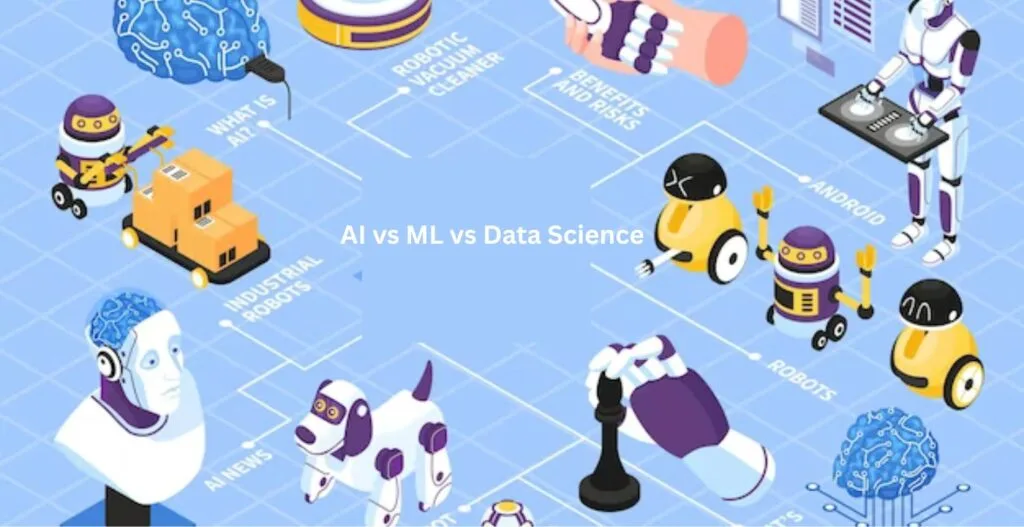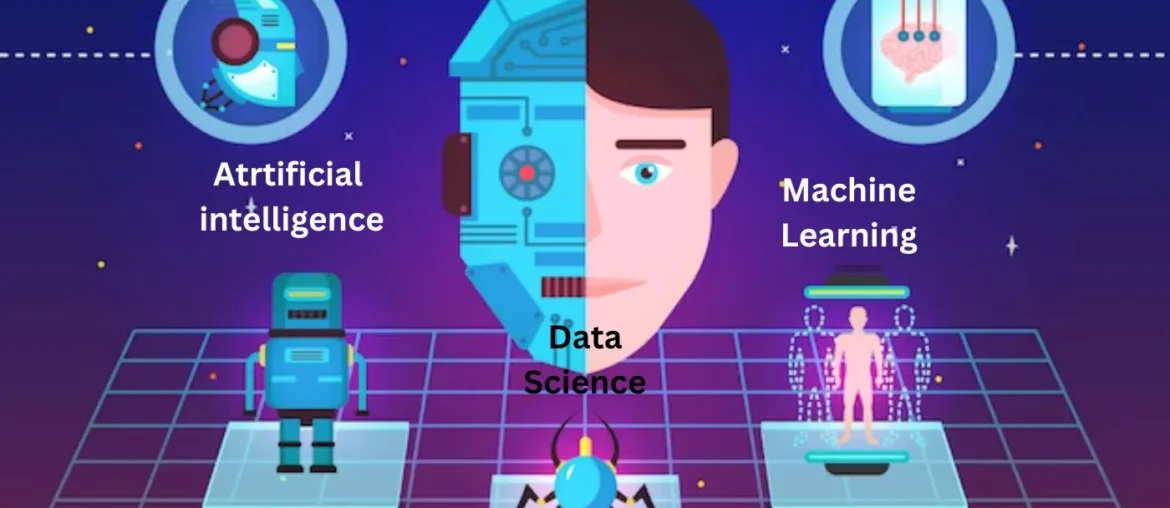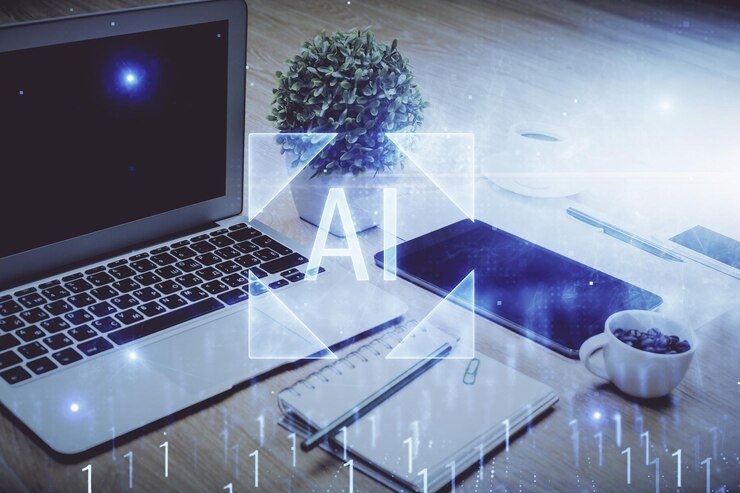Artificial Intelligence (AI), Machine Learning (ML), and Data Science are becoming more and more common in today’s fast-paced technological environment. AI vs ML vs Data Science are the cornerstones of technological advancement. Machine learning (ML) uses algorithms to help machines learn from data and make predictions, artificial intelligence (AI) includes the creation of intelligent machines that can replicate human behavior. We are going to explain these concepts and understand their unique contributions to the development of our digital world.
AI vs ML vs Data Science
What is (AI)Artificial Intelligence?
The term artificial intelligence (AI) describes computer programs created to carry out operations that normally call for human intelligence. It includes creating algorithms and systems with the ability to analyze data, spot trends, come to conclusions, and resolve issues. AI is a broad field that includes technologies such as natural language processing and neural networks, with the goal of simulating human thought processes. Applications for it include financial forecasts, healthcare diagnostics, driverless cars, and virtual assistants. AI is still developing, changing industries as it increases human skills, boosts productivity, and makes innovations possible that change how we work and live.
Key Features of Artificial Intelligence
Learning Capability:
Without explicit programming, AI systems are able to learn from data, enhancing performance and adjusting to new facts.
Problem Solving:
AI is capable of solving complex problems in a variety of fields, from healthcare diagnostics to logistical operations optimization, due to its algorithms and processing capacity.
NLP(Natural language Processing):
Artificial Intelligence (AI) facilitates human-computer communication by allowing machines to understand, interpret, and produce human language through Natural Language Processing (NLP). Tools for translating languages and virtual assistants are two examples of applications.
Computer Vision:
AI enables machines to analyze and interpret visual data from pictures or videos in a way that is similar to how humans see. This feature is essential for autonomous car navigation, object identification, and facial recognition.
Automation:
AI enables machines to carry out jobs that have historically required human oversight, which facilitates automation. This covers everything from production procedures to chatbot-based customer support.
Predictive analytics:
Based on past data, AI may predict future outcomes by applying machine learning techniques. This ability helps with anticipating trends in a variety of industries and making well-informed decisions.
Self-correction and adaptability:
AI systems have the capacity to change with their surroundings and get better over time. They have the ability to self-correct mistakes, improving their operational precision and efficiency.
What is (ML)Machine Learning?
Machine learning (ML) is the process of teaching computers, without explicit programming, to learn from data and get better over time. It’s a branch of artificial intelligence (AI) that gives systems the ability to recognize trends, forecast outcomes, and improve decisions through experience. When faced with fresh knowledge, ML algorithms use data to train models, which then adapt and improve their understanding. Examples of these systems include self-driving cars, recommendation systems, and speech and image recognition.
Key Features of Machine Learning
Learning from Data:
By examining huge amounts of data, machine learning algorithms discover patterns and make decisions. As they come across new information, these algorithms get better and better at what they do.
Adaptability and Generalization:
ML models possess the ability to adjust to new data and circumstances, allowing them to apply their knowledge to generate predictions or judgments that go beyond the parameters of the training set.
Automation:
By enabling systems to learn and develop on their own, machine learning (ML) automates the process of creating analytical models, eliminating the need for manual programming.
Continuous Improvement:
Machine learning models improve accuracy and performance over time by continually improving themselves through ongoing learning from fresh data.
Prediction and Decision-Making:
Machine learning (ML) facilitates forecasting and decision-making by allowing computers to forecast or make decisions based on learnt patterns.
Pattern Recognition:
Machine learning algorithms are particularly good at identifying complex connections and patterns in data that are difficult for people or conventional algorithms to notice.
Scalability:
ML algorithms are able to efficiently analyze and extract insights from vast amounts of data by scaling to handle big and diverse datasets.
Understanding the basics of Data Science
Data science is the process of collecting knowledge and insights from complex and frequently sizable datasets. In order to gather, process, and understand data, it combines a number of academic fields, including computer science, statistics, and domain expertise. Data scientists use methods like machine learning, data mining, and visualization to find trends, patterns, and correlations that help them make well-informed decisions. Data science strengthens industries by utilizing data to solve issues, make predictions, and discover important insights that stimulate creativity and development in a variety of fields, including healthcare, user experiences, and market trends and strategy optimization.
Key Features of Data Science
Multidisciplinary Technique:
Data science combines information from several disciplines, including computer science, statistics, domain knowledge, and business expertise. It makes use of these many fields to gather knowledge and solve challenging issues.
Data Collection and Analyzing:
Gathering, purifying, and analyzing vast amounts of heterogeneous data from many sources are all part of the data collection and processing process. By doing this, you may be confident the data is correct, pertinent, and prepared for analysis.
Exploratory Data Analysis (EDA):
Data scientists use exploratory data analysis, or EDA, to determine the links, trends, and structure of a dataset. Finding patterns and unusual events can be helped by statistical techniques and visualization tools.
Machine Learning and Predictive Modeling:
To create predictive models, data scientists use machine learning algorithms. These models assist in decision-making by using data patterns to generate projections, suggestions, or classifications.
Handling Big Data:
Data science works with large datasets that are more complex to handle than can be done using conventional data processing techniques. For effective handling, methods like cloud-based solutions and distributed computing are used.
Feature engineering and selection:
This process involves figuring out which relevant factors or features provide the biggest contributions to the prediction models. This method improves the efficiency and accuracy of the model.
Communication and Storytelling:
Data scientists use reports, narratives, and visualizations to effectively convey their findings to stakeholders. Data storytelling facilitates the communication of insights and suggestions for well-informed decision-making.

Key Differences
Scope and Focus:
Artificial intelligence, or AI, is a vast field that includes the development of devices or systems that are capable of carrying out activities that call for human intelligence. It uses a variety of methods to mimic human-like perception, reasoning, and problem-solving, including robots, machine learning, and natural language processing.
Machine learning, or ML, is a branch of artificial intelligence that focuses on creating algorithms that let computers learn from data and get better over time without the need for explicit programming. It involves teaching robots to recognize patterns and draw conclusions from past experiences.
Data science: Data science is the process of applying a variety of tools, techniques, and procedures to extract knowledge and insights from data. It is a multidisciplinary field that uses data processing, analysis, comprehension, and buying to solve challenging issues and aid in decision-making.
Objectives and Applications:
Artificial Intelligence (AI): AI seeks to build intelligent machines that can carry out tasks that normally require human intelligence, like understanding natural language, identifying patterns in data, coming to conclusions, and even acting on their own.
Machine Learning (ML): ML is the study of creating algorithms that can learn from data to provide classifications, predictions, or judgments. Predictive analytics, picture and speech recognition, and recommendation systems are a few examples of applications.
Data science: The goal of data science is to derive knowledge and insights that may be used to support decision-making processes across a range of industries, including business, healthcare, and finance.
Techniques and Methods:
Artificial Intelligence (AI): AI includes a broad range of methods, such as robots, computer vision, machine learning, and natural language processing.
ML: Among other algorithms and methods, ML includes deep learning, reinforcement learning, unsupervised learning, and supervised learning.
Data Science: To extract insights and value from data, data science uses statistical analysis, data mining, machine learning, data visualization, and domain expertise.
The Future of AI, ML, and Data Science
AI, ML, and Data Science are developing together with technology, driving advances in finance, healthcare, and other fields. The ethical implications of AI’s societal effects and data privacy continue to be crucial, calling for careful progress in these areas.
Conclusion
In a growing technologically dependent world, the differences and interconnections across AI vs ML vs Data Science are critical. Recognizing how they work together and embracing their distinct strengths will open the door to ground-breaking discoveries that will transform both social environments and industries.




